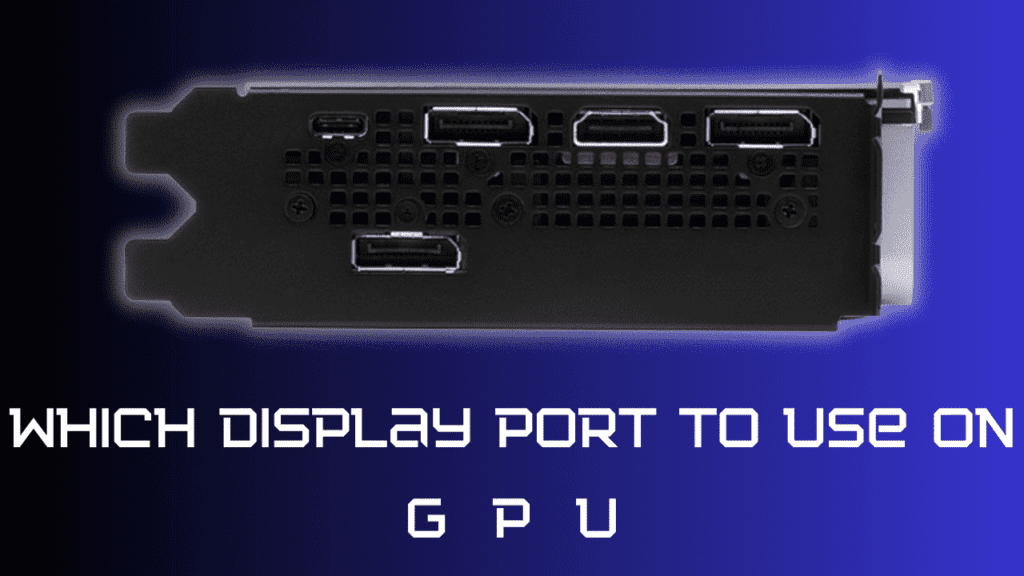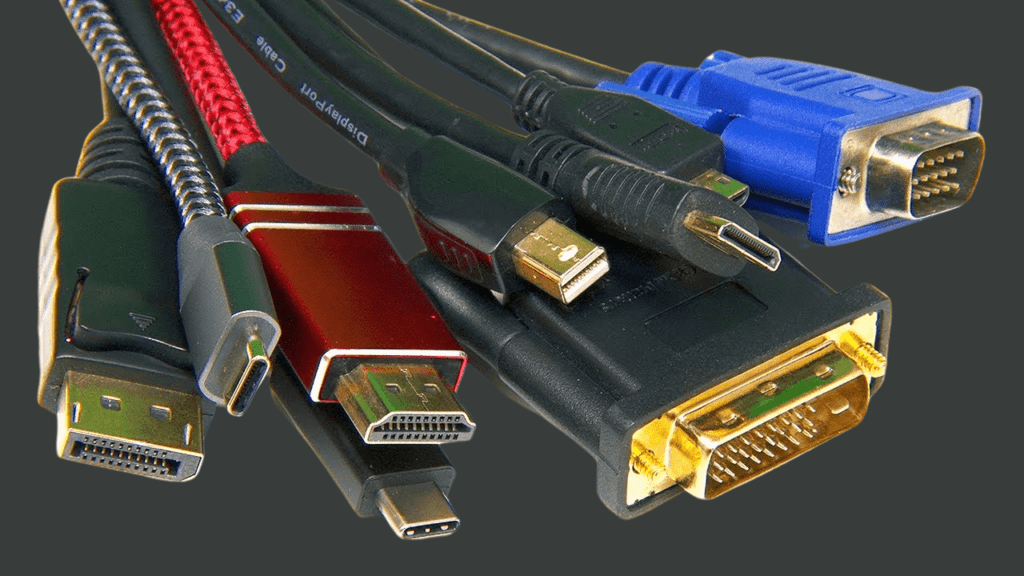
Unsure Which Display Port to Use on GPU? We’ve Got You Covered. There are so many options these days – HDMI, DisplayPort, DVI, even VGA.How do you know which one is right for you and will give you the best performance?
In this complete guide, we’ll walk you through the different display ports, explain what each one does (and doesn’t do), helping you choose the best choice for your particular GPU and monitor setup.
Understanding the DisplayPort on GPUs
DisplayPort is a digital display interface standard that’s become very popular for connecting PCs to monitors and TVs. Most dedicated graphics cards these days come with multiple DisplayPort outputs, allowing you to connect multiple monitors at once.
Resolution and Refresh Rates
DisplayPort offers significantly more bandwidth than older standards like VGA, DVI, and HDMI. This means it can handle higher resolutions and refresh rates, which is ideal for gaming and other intensive tasks. DisplayPort 1.4, the latest version, supports up to 8K resolution at 60Hz or 4K resolution at 120Hz.
G-Sync and FreeSync Support
DisplayPort also supports variable refresh rate technologies like NVIDIA G-Sync and AMD FreeSync. These match your monitor’s refresh rate to your GPU’s frame rate, reducing stuttering and screen tearing in games for a super smooth experience.
Daisy-Chaining Multiple Monitors
Some DisplayPort monitors also support daisy-chaining, allowing you to connect multiple monitors in a chain to your PC using only one DisplayPort cable.This can help reduce cable clutter on your desk. However, the total resolution and refresh rate supported will depend on your specific monitor models.
With its high bandwidth, VRR support, and daisy-chaining abilities, DisplayPort is an excellent choice for connecting your dedicated gaming GPU to a high-performance monitor setup. When shopping for new monitors or graphics cards, be sure to consider which DisplayPort standards they support to get the best experience.
Types of DisplayPort Connections
DisplayPort comes in a few different versions these days. The most common are DisplayPort 1.2, DisplayPort 1.3, and DisplayPort 1.4. Each version builds upon the last, offering more advanced features and higher bandwidth.

DisplayPort 1.2
DP 1.2 supports up to 17.28 Gbps of bandwidth, which is enough for a single 4K display at 60Hz or two 1440p displays. It’s the most widely used DP standard and should work with most modern GPUs and monitors.
DisplayPort 1.3
DP 1.3 doubled the bandwidth to 32.4 Gbps, enabling 5K resolution at 60Hz or up to four 4K displays. DP 1.3 requires compatible GPUs and monitors, though many recent models do support it. If you want to power a 5K or multi-4K setup, DP 1.3 is a must.
DisplayPort 1.4
The latest DP version can do it all. With bandwidth up to 32.4 Gbps, DP 1.4 supports 8K resolution at 60Hz, 10K resolution, and even 16K resolution for commercial applications. It also enables HDR for brighter highlights and deeper blacks. Of course, DP 1.4 requires the latest graphics cards and monitors, so it may be overkill for most people right now. But if you want the best of the best, this is the DisplayPort standard to get.
As you can see, the type of DisplayPort you need depends on your desired resolution, refresh rate, and display setup. In the end, choose a connection that suits your needs and budget. Your gorgeous new gaming monitor will be worth it!
Tips for Picking the Right DisplayPort
DisplayPort technology has evolved a lot over the years. There are now several versions of DisplayPort available, so choosing the right one for your needs can be confusing. Here are some tips to help you select the perfect DisplayPort for your GPU.
Consider your display resolution and refresh rate
If you have a 4K monitor or want to run high refresh rates (over 60Hz), you’ll want a newer DisplayPort version like DisplayPort 1.4. Older versions like DisplayPort 1.2 may struggle to handle these higher resolutions and frame rates. DisplayPort 1.4 can handle 8K resolution at 60Hz or 4K resolution at 144Hz.
Think about your cable length
The newer your DisplayPort version, the longer your cable can be. DisplayPort 1.4, for example, supports cable lengths up to 2 meters for 4K at 60Hz or 1 meter for 4K at 144Hz. If you need a longer cable run for your setup, a newer DisplayPort version is better.
Look at your graphics card specs
Make sure your graphics card actually supports the DisplayPort version you want to use. Newer cards will typically have the latest DisplayPort connections, while older cards may be limited to DisplayPort 1.2 or below. There’s no point in buying an expensive DisplayPort 1.4 cable if your graphics card can’t utilize it!
Consider your budget
DisplayPort cables and ports that support the latest versions like DisplayPort 1.4 tend to cost a bit more. If you’re on a tight budget, an older but still capable version like DisplayPort 1.2 may suit your needs just fine, especially for lower resolution or refresh rate displays.
By taking these factors into account, you can choose a DisplayPort version that’s ideal for your GPU, monitor, and other setup needs. The latest versions offer more capabilities but the older versions can still work great and may save you some money. In the end, pick what suits your needs and budget the best.
Which Display Port Should I Use on My GPU?
As graphics cards have become more powerful, the ports used to connect monitors have also advanced. Your GPU likely supports multiple display standards—so which should you use? Let’s break down the options.

HDMI
HDMI is a popular, universal connection that you’ll find on most monitors and TVs. It’s easy to use and supports high resolutions and refresh rates, up to 4K at 60Hz or 1440p at 144Hz, which is plenty for most gaming and multimedia needs. The downside is that HDMI cables are often more expensive, especially if you need a long cable. HDMI is a good all-purpose choice if you have a standard 1080p or 1440p monitor.
DisplayPort
DisplayPort or DP is a standard developed specifically for connecting PCs to monitors. It supports higher resolutions and refresh rates than HDMI, up to 8K at 60Hz or 4K at 144Hz. DisplayPort cables also tend to be less expensive than HDMI. The downside is that not all monitors support DisplayPort, though most gaming monitors do. If you have a high-performance gaming monitor, especially one with a refresh rate of 120Hz or higher, DisplayPort is probably your best choice.
DVI
DVI is an older standard and is being phased out in favor of HDMI and DisplayPort. While DVI does support high refresh rates and resolutions, the cables are more expensive and less versatile. Unless your monitor only supports DVI, we don’t recommend using it.
We suggest going with either HDMI or DisplayPort, depending on your monitor’s capabilities and your needs. And of course, if your monitor has more than one input, you can always try different ports to see which one you prefer!
In which DP port should I plug my main monitor?
It Doesn’t Usually Matter Which DP Port You Use for Your Main Monitor. Most graphics cards with DisplayPort (DP) ports treat them equally. So, pick any DP that’s convenient for your cable management. However, if you’re facing issues, consult your graphics card manual or try a different DP port.
Does it matter which display port on the GPU I use?
No, it typically does not matter which display port on the GPU you use for connecting your monitor. They are designed to provide the same functionality and performance, so you can use any available port without significant differences.
Pros and Cons of Display Port on GPU
| Ports | HDMI | DisplayPort | DVI |
| Pros | Single cable (AV), widely supported | High resolution & refresh, multi-monitor | High refresh rate (1080p), older compatible |
| Cons | Limited high refresh rate (older versions) | Less common on TVs, specific cable version | Limited resolution, no audio, outdated |
In the end, whether you choose DisplayPort or HDMI comes down to your specific needs and setup. For high performance PC gaming and the best multi-display experience, DisplayPort is hard to beat. But for more basic needs, HDMI will work just fine and may save you a few bucks. Evaluate your priorities and go with what makes the most sense for your situation.
FAQs
What is a Display Port (DP) on a GPU?
- A Display Port (DP) is a digital interface used to connect monitors or displays to a computer’s graphics processing unit (GPU). It enables high-resolution visuals and supports various display technologies.
How many types of Display Ports are there on a GPU?
- Typically, modern GPUs offer multiple types of Display Ports, including DisplayPort 1.2, DisplayPort 1.4, HDMI, and sometimes older standards like DVI or VGA.
Which Display Port to use on GPU?
- The choice of Display Port depends on factors like the display resolution, refresh rate, and supported technologies. For optimal performance, use the latest version available on both your GPU and monitor.
What are the differences between DisplayPort versions?
- Newer DisplayPort versions offer enhancements like increased bandwidth, higher resolutions, and improved support for features such as HDR (High Dynamic Range) and adaptive sync technologies like FreeSync and G-Sync.
Can I use any Display Port for my monitor?
- While most modern GPUs support backward compatibility, using the latest version of DisplayPort ensures compatibility with newer monitors and unlocks advanced features. However, older versions may still work depending on your specific setup.
What if my monitor doesn’t have a DisplayPort?
- If your monitor lacks a DisplayPort but supports other interfaces like HDMI, you can use adapters or converters to connect it to your GPU. Ensure the adapter supports the required resolutions and refresh rates for your display.
Do different Display Ports affect performance?
- In general, the choice of Display Port doesn’t significantly impact performance unless you’re utilizing advanced features like high refresh rates or HDR. Using the latest version ensures compatibility with future technologies and optimizations.
Should I prioritize DisplayPort over HDMI?
- DisplayPort typically offers more features and higher bandwidth compared to HDMI, making it preferable for high-resolution gaming or professional use. However, HDMI remains widely compatible and may be more suitable for certain setups.
How can I identify the version of DisplayPort on my GPU?
- You can usually find information about the DisplayPort version in the specifications of your GPU provided by the manufacturer. Additionally, the physical port may be labeled with the version number (e.g., DisplayPort 1.2, DisplayPort 1.4).
Conclusion
The choice between DisplayPort, HDMI, and DVI comes down to your needs. If you want the highest resolution and refresh rates, DisplayPort is the way to go. But HDMI and DVI have their benefits too. Just remember that more bandwidth is better for gaming, and active cables can push higher resolutions. Pick the port that makes the most sense for your monitor, GPU, and gaming style. The differences might seem complicated at first, but a little research goes a long way.